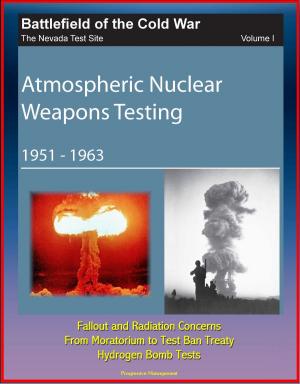Arctic Operations and the Northwest Passage: Department of Defense (DOD) Report to Congress on the Effect of Climate Change, Arctic Warming, National Security, Infrastructure, Icebreakers
Nonfiction, Social & Cultural Studies, Political Science, Government, Public Policy| Author: | Progressive Management | ISBN: | 9781465904218 |
| Publisher: | Progressive Management | Publication: | March 8, 2012 |
| Imprint: | Smashwords Edition | Language: | English |
| Author: | Progressive Management |
| ISBN: | 9781465904218 |
| Publisher: | Progressive Management |
| Publication: | March 8, 2012 |
| Imprint: | Smashwords Edition |
| Language: | English |
This is a flowing-text ebook format reproduction of an important Department of Defense (DOD) report on Arctic operations addressing strategic national security objectives, needed mission capabilities, an assessment of changing the Unified Command Plan (UCP), needed basing infrastructure, and the status of and need for icebreakers.
Section One provides the overarching context for the rest of the report and assesses the national security objectives in the region.
Section Two assesses the capabilities needed to support the identified strategic objectives and, where gaps are identified, describes mitigation approaches to address them.
Section Three assesses the advantages and disadvantages of amending the Unified Command Plan to designate a single Combatant Commander for the Arctic region.
Section Four assesses the basing infrastructure needed to support the identified strategic objectives, including the need for a U.S. deep-water port in the Arctic.
Section Five assesses the status of and need for icebreakers in the context of the capabilities to support national security objectives.
The Arctic is warming on average twice as fast as the rest of the planet, resulting in increased human activity in the region. Although some perceive that competition for resources and boundary disputes may result in conflict in the Arctic, the opening of the Arctic also presents opportunities to work collaboratively in multilateral forums to promote a balanced approach to improving human and environmental security in the region.
Strategic guidance on the Arctic is articulated in National Security Presidential Directive (NSPD) 66 / Homeland Security Presidential Directive (HSPD) 25, Arctic Region Policy. Additional guidance is found in the 2010 National Security Strategy (NSS) and the 2010 Quadrennial Defense Review (QDR). The overarching strategic national security objective is a stable and secure region where U.S. national interests are safeguarded and the U.S. homeland is protected. This objective is consistent with a regional policy that reflects the relatively low level of threat in a region bounded by nation states that have not only publicly committed to working within a common framework of international law and diplomatic engagement, but also demonstrated ability and commitment to doing so over the last fifty years.
DoD will take responsible steps to anticipate and prepare for the Arctic operations of the near-(2010-2020), mid- (2020-2030), and far-term (beyond 2030). Capabilities will need to be re-evaluated as conditions change, and gaps must be addressed in order to be prepared to operate in a more accessible Arctic. Key challenges include: shortfalls in ice and weather reporting and forecasting; limitations in command, control, communications, computers, intelligence, surveillance, and reconnaissance (C4ISR) due to lack of assets and harsh environmental conditions; limited inventory of ice-capable vessels; and limited shore-based infrastructure. The key will be to address needs in step with the rate at which activity in the Arctic increases, and balance potential investments in these capabilities with other national priorities. The United States has a vital Arctic neighbor and partner in Canada, with its shared values and interests in the region. DoD will work with the Canadian Department of National Defence (DND) to ensure common Arctic interests are addressed in a complementary manner.
This is a flowing-text ebook format reproduction of an important Department of Defense (DOD) report on Arctic operations addressing strategic national security objectives, needed mission capabilities, an assessment of changing the Unified Command Plan (UCP), needed basing infrastructure, and the status of and need for icebreakers.
Section One provides the overarching context for the rest of the report and assesses the national security objectives in the region.
Section Two assesses the capabilities needed to support the identified strategic objectives and, where gaps are identified, describes mitigation approaches to address them.
Section Three assesses the advantages and disadvantages of amending the Unified Command Plan to designate a single Combatant Commander for the Arctic region.
Section Four assesses the basing infrastructure needed to support the identified strategic objectives, including the need for a U.S. deep-water port in the Arctic.
Section Five assesses the status of and need for icebreakers in the context of the capabilities to support national security objectives.
The Arctic is warming on average twice as fast as the rest of the planet, resulting in increased human activity in the region. Although some perceive that competition for resources and boundary disputes may result in conflict in the Arctic, the opening of the Arctic also presents opportunities to work collaboratively in multilateral forums to promote a balanced approach to improving human and environmental security in the region.
Strategic guidance on the Arctic is articulated in National Security Presidential Directive (NSPD) 66 / Homeland Security Presidential Directive (HSPD) 25, Arctic Region Policy. Additional guidance is found in the 2010 National Security Strategy (NSS) and the 2010 Quadrennial Defense Review (QDR). The overarching strategic national security objective is a stable and secure region where U.S. national interests are safeguarded and the U.S. homeland is protected. This objective is consistent with a regional policy that reflects the relatively low level of threat in a region bounded by nation states that have not only publicly committed to working within a common framework of international law and diplomatic engagement, but also demonstrated ability and commitment to doing so over the last fifty years.
DoD will take responsible steps to anticipate and prepare for the Arctic operations of the near-(2010-2020), mid- (2020-2030), and far-term (beyond 2030). Capabilities will need to be re-evaluated as conditions change, and gaps must be addressed in order to be prepared to operate in a more accessible Arctic. Key challenges include: shortfalls in ice and weather reporting and forecasting; limitations in command, control, communications, computers, intelligence, surveillance, and reconnaissance (C4ISR) due to lack of assets and harsh environmental conditions; limited inventory of ice-capable vessels; and limited shore-based infrastructure. The key will be to address needs in step with the rate at which activity in the Arctic increases, and balance potential investments in these capabilities with other national priorities. The United States has a vital Arctic neighbor and partner in Canada, with its shared values and interests in the region. DoD will work with the Canadian Department of National Defence (DND) to ensure common Arctic interests are addressed in a complementary manner.















